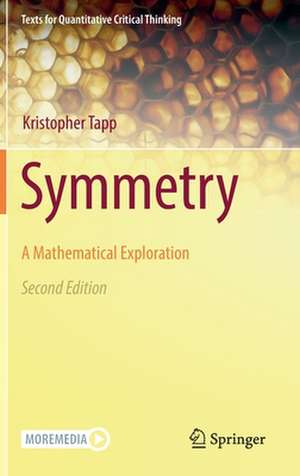Symmetry: A Mathematical Exploration: Texts for Quantitative Critical Thinking
Autor Kristopher Tappen Limba Engleză Hardback – 29 aug 2021
The exposition is engaging, precise and rigorous. The theorems are visually motivated with intuitive proofs appropriate for the intended audience. Students from all majors will enjoy the many beautiful topics herein, and will come to better appreciate the powerful cumulative nature of mathematics as these topics are woven together into a single fascinating story about the ways in which objects can be symmetric.
| Toate formatele și edițiile | Preț | Express |
|---|---|---|
| Paperback (2) | 351.00 lei 6-8 săpt. | |
| Springer – 23 aug 2016 | 351.00 lei 6-8 săpt. | |
| Springer International Publishing – 30 aug 2022 | 363.36 lei 38-44 zile | |
| Hardback (1) | 360.74 lei 3-5 săpt. | +29.75 lei 4-10 zile |
| Springer International Publishing – 29 aug 2021 | 360.74 lei 3-5 săpt. | +29.75 lei 4-10 zile |
Preț: 360.74 lei
Nou
69.05€ • 75.03$ • 58.04£
Carte disponibilă
Livrare economică 31 martie-14 aprilie
Livrare express 14-20 martie pentru 39.74 lei
Specificații
ISBN-10: 3030516687
Pagini: 336
Ilustrații: XII, 259 p. 300 illus., 289 illus. in color.
Dimensiuni: 155 x 235 x 24 mm
Greutate: 0.56 kg
Ediția:2nd ed. 2021
Editura: Springer International Publishing
Colecția Springer
Seria Texts for Quantitative Critical Thinking
Locul publicării:Cham, Switzerland
Cuprins
Preface.- 1. Introduction to Symmetry.- 2. The Algebra of Symmetry.- 3. The Classification Theorems.- 4. Isomorphic Groups.- 5. Subgroups & Product Groups.- 6. Permutation Groups.- 7. Symmetries of 3D Objects.- 8. The Five Platonic Solids.- 9. Symmetry and Optimization.- 10. What is a Number?.- 11. Excursions in Numbers.- 12. Rigid Motions as Functions.- 13. Rigid Motions as Matrices.- Image Credits.- Index.
Recenzii
Notă biografică
Kristopher Tapp is Professor of Mathematics at Saint Joseph's University in Philadelphia. The recipient of numerous teaching awards, he is particularly interested in communicating ideas from mathematics to students in other fields. His research extends from differential geometry to the mathematical study of gerrymandering. Previous books include Differential Geometry of Curves and Surfaces, which appears in Undergraduate Texts in Mathematics.
Textul de pe ultima copertă
This textbook invites readers to explore the properties of objects that we effortlessly recognize as symmetrical. From the human body, to elaborate artworks and abstract networks, symmetry is ubiquitous in the world around us; it is essential to function and beauty across the built and natural world. By developing mathematical language to describe symmetry, this textbook equips readers to explore symmetries with precision, illuminating commonalities across art and science.
Beginning with an exploration of intuitive notions of symmetry, the author introduces the algebraic structure of groups by examining rotations and reflections. Topics that follow include the classification of two-dimensional patterns, the Platonic solids, and a study of real and prime numbers. This second edition features numerous new examples and exercises, “Elements of Mathematics” sections that more closely examine mathematical tools, and optional content that offers opportunities for extension. Figures are woven into the presentation throughout, with many illustrations now offered in motion as integrated video content. Symmetry suits a wide audience, demanding no mathematical training past high school basics, yet stretching the imagination of math and non-math majors alike. Its engaging yet rigorous style offers a window into mathematicians’ ways of thinking. By developing mathematical reasoning skills in a spatial context, this text is ideal for a course that meets quantitative requirements for non-STEM majors. Instructors will appreciate the author’s comprehensive online resources, which include a full set of animated lecture slides; all readers will delight in watching the book’s content come alive using the multimedia app.
Caracteristici
Supports instructors with a complete set of animated lecture slides prepared by the author
Offers an appealing spatial approach to meeting quantitative requirements for non-STEM majors
Brings countless illustrations to life using the Springer Nature “More Media” app
Descriere
This textbook is perfect for a math course for non-math majors, with the goal of encouraging effective analytical thinking and exposing students to elegant mathematical ideas. It includes many topics commonly found in sampler courses, like Platonic solids, Euler’s formula, irrational numbers, countable sets, permutations, and a proof of the Pythagorean Theorem. All of these topics serve a single compelling goal: understanding the mathematical patterns underlying the symmetry that we observe in the physical world around us.
The exposition is engaging, precise and rigorous. The theorems are visually motivated with intuitive proofs appropriate for the intended audience. Students from all majors will enjoy the many beautiful topics herein, and will come to better appreciate the powerful cumulative nature of mathematics as these topics are woven together into a single fascinating story about the ways in which objects can be symmetric.

